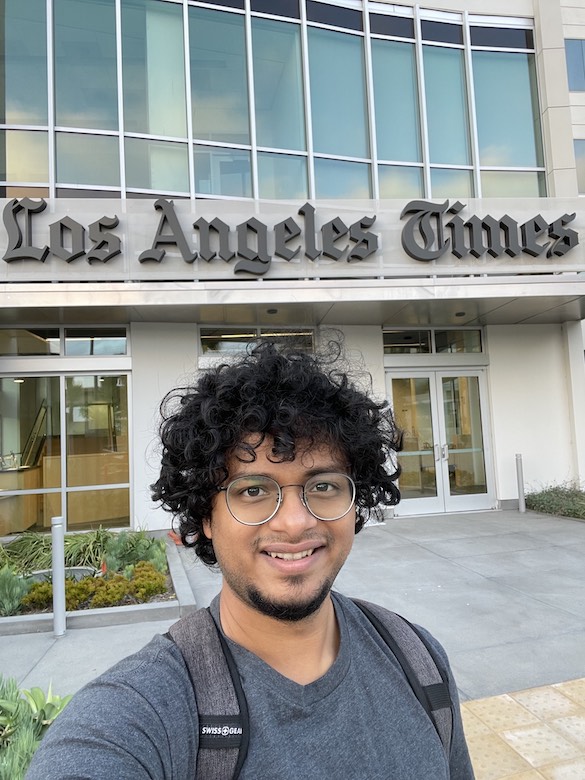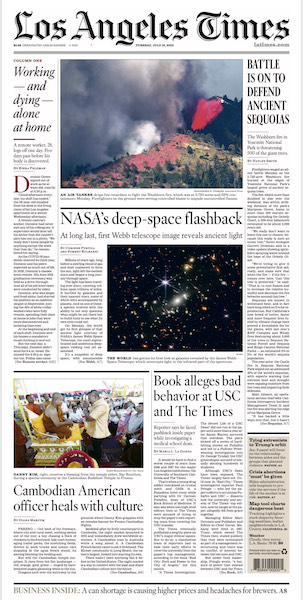Building communications in science through AAAS fellowship

Sumeet Kulkarni, a PhD student with the Department of Physics and Astronomy at the University of Mississippi, in front of the Los Angeles Times office during his American Association for the Advancement of Science fellowship.
DECEMBER 15, 2022 BY ABIGAIL MARTIN
Sumeet Kulkarni is a PhD student with the Department of Physics and Astronomy at the University of Mississippi who interned with the Los Angeles Times over the summer writing science articles for the publication.
Kulkarni applied and was accepted into the American Association for the Advancement of Science’s fellowship program, which is open to all science students. “I was an AAAS Mass Media Fellow. Every year they have a summer fellowship for graduate students in the sciences, mathematics, and engineering who are interested in science writing for the public.”
Fellows are placed at media organizations nationwide where they use their academic training as they research, write and report today’s headlines, sharpening their abilities to communicate complex scientific issues to the public.
“Through this fellowship, I was placed with the Los Angeles Times, and I spent about two and a half months there—10 weeks basically being a reporter for the science desk, and that was an incredible experience,” he said.
“The cool thing is that everyone goes to a different place. Some people go to science specific outlets like Scientific American or Discover Magazine, others, like me, go to media outlets with more variety. The Los Angeles Times newspaper has a breadth of coverage. There are a broad variety of outlets in the program.”
Physics department chair, Luca Bombelli, speaks to the benefits of the mass media fellowship, “I think that it is very important for physicists to not only be good at their work, but also be able to explain what they do to the wider community. This opportunity is a great way to increase those skills.”

“NASA’s deep-space flashback” is one of the Los Angeles Times front page stories written by Sumeet Kulkarni during his American Association for the Advancement of Science fellowship.
Along with the summer-long stay with media organizations, fellows have the opportunity to interact with one another during the process. “There is an orientation in Washington, DC at the AAAS office so that the fellowship students can meet each other. It’s a great place to make friends. Then after the fellowship, we get back together, having many different experiences to share, which is an excellent part of the fellowship—to network with like-minded science journalists,” Kulkarni explained.
During his tenure, he conducted interviews and covered several different scientific concerns, “I wrote 12 articles and made a video for one of the stories I reported on about light pollution. It was a mix of news articles covering one single research study and broader feature type of articles.”
Kulkarni participated in the fellowship because of his interest in the field. “I want to get into science communication, and I’ve been trying to find my own niche. It’s a broad and developing field—as in that there is no set path. I got a flavor of hardcore journalism, and I loved my experience because it is much faster than grad school—research is slow as it should be—being at the Los Angeles Times allowed me to cover a breadth of topics.”
However, that was not the only aspect of his experience he enjoyed. He describes his excitement on having his stories reach the front-page. “It was cool to see my stories come out in print and a couple of them even made the front page. My editor sent me the best souvenir—press plates used in the printing press process for my front-page stories and that was absolutely mind blowing.
“I was happy to see my light pollution story on the front page of the newspaper and how it had a little bit of an impact. It was about a bill in the California state legislature about light pollution that Governor Newsom ended up vetoing, but after the story, there’s been increased awareness about light pollution in general.
“If we don’t regulate LEDs—the light from LEDs is bluer and more intensely circulated and spreads into the sky without any control—it affects a lot of things like bird migration, even human health. Because I was able to increase awareness on this issue, I feel I can use my reporting to try and make a change,” he said.
Some of Kulkarni’s favorite stories were the ones he wrote about space. “I’m a big space nerd, and I got to write about the NASA Voyager missions. They recently completed 45 years in space and they’re still communicating with us. I wrote about how that is the world’s longest phone call that’s still ongoing. Scientists are hard at work to keep it going as long as possible. For that story, I interviewed Bill Nye the Science Guy—I still don’t believe it happened.
“I had to get broad perspective quotes from someone and my editor suggested I contact Neil deGrasse Tyson, who is really hard to get in touch with, but Bill Nye wasn’t. That’s one of the favorite stories I’ve written.”
Seeing as Bill Nye is the face of science to younger generations, Kulkarni was not expecting to have the opportunity to talk with such a celebrity. “He happens to be the CEO of the Planetary Society, which is a good connection for writing about the Voyagers because they made so many discoveries about the solar system. So, I wrote to their press office saying that I’m writing a story for the LA Times and that I would like to interview Bill Nye. They got back immediately, saying they’d see what they could do about it—and I thought they were being polite.
“The next week I followed up, not expecting much but the woman in charge said ‘oh, Bill is free tomorrow for a call between 1 and 3pm.’ Then I freaked out about what to ask him. Normally, I ask scientists to introduce themselves, but I didn’t know if I needed to in his case.
“When Bill Nye started speaking in his iconic voice, it felt surreal. He answered pretty much the way I thought he would—he had this overarching perspective of looking at things,” Kulkarni said. “I was fairly calm, but that night I received a notification on my phone from the health app saying that just after the interview my heartrate rose when I was seemingly physically inactive.”
Another space-based story Kulkarni wrote was about the work of his fellow graduate students in the field. “I pitched my idea to the Los Angeles Times about how graduate students are using the James Webb Space Telescope early in their careers.
“They’ve written proposals to use the telescope that have been accepted and they’re making observation plans. That’s really good for starting out astronomers get to use this $10 billion swanky new telescope. I talked to six such grad students who are doing it—and being a grad student myself—I was happy to give them this platform recognizing all their hard work,” he said.
READ SUMEET KULKARNI’S STORIES IN THE LOS ANGELES TIMES.